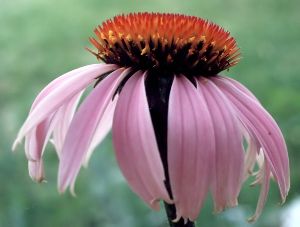Purple Coneflower
by Valerie (June 8, 2000)
revised August 24, 2003
 Beyond some extra watering and a small amount of thinning and weeding, we don't coddle the plants in our gardens. One of the main ways I add plants to our gardens is to broadcast seeds that have been collected during the previous months and see what grows. Beyond some extra watering and a small amount of thinning and weeding, we don't coddle the plants in our gardens. One of the main ways I add plants to our gardens is to broadcast seeds that have been collected during the previous months and see what grows. Purple coneflowers (Echinacea sanguinea) are quite rewarding in that we now have a number of healthy, blossom-producing plants from just smashing some dried seed heads into the mud. The first year, they were like most perennials: small and slow-growing, but ever since, the long-lasting blooms begin by late spring and continue all summer. They are growing in partial shade to almost full sun and do fine in both situations. Purple coneflowers (Echinacea sanguinea) are quite rewarding in that we now have a number of healthy, blossom-producing plants from just smashing some dried seed heads into the mud. The first year, they were like most perennials: small and slow-growing, but ever since, the long-lasting blooms begin by late spring and continue all summer. They are growing in partial shade to almost full sun and do fine in both situations.
The coneflowers are in the sunflower family (Asteraceae), having the same large central disk with numerous tiny flowers arrayed in a pleasing symmetrical pattern. The big difference is that the disk swells upwards as it grows (forming the cone) and the outer ray flower petals droop down. A lot of flowers look nice from above, but these have a distinguished profile as well. The roots are thick and tuberous and have medicinal properties. The genus name Echinacea means "hedgehog" and refers to the spiny chaff of the central disk flowers. The same Greek word is the basis for the name echinoderms: the spiny-skinned starfish and sea urchins, and that's just what the center of the purple coneflower looks (and feels) like. |